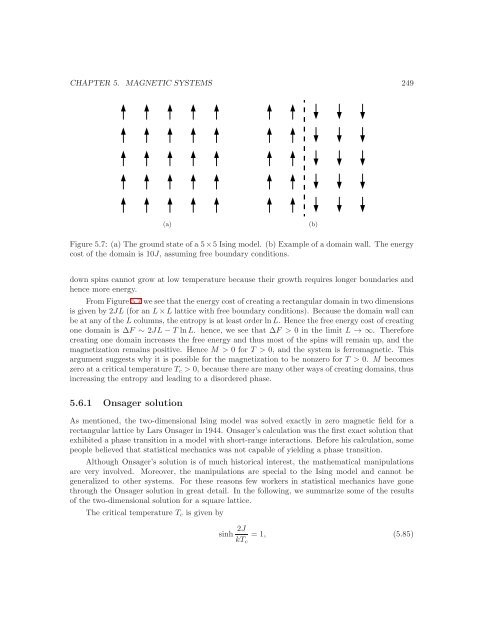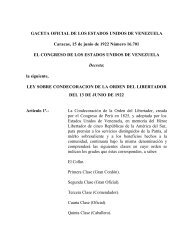Chapter 5 - WebRing
Chapter 5 - WebRing
Chapter 5 - WebRing
Create successful ePaper yourself
Turn your PDF publications into a flip-book with our unique Google optimized e-Paper software.
CHAPTER 5. MAGNETIC SYSTEMS 249<br />
(a) (b)<br />
Figure 5.7: (a) The ground state of a 5×5 Ising model. (b) Example of a domain wall. The energy<br />
cost of the domain is 10J, assuming free boundary conditions.<br />
down spins cannot grow at low temperature because their growth requires longer boundaries and<br />
hence more energy.<br />
FromFigure5.7weseethatthe energycostofcreatingarectangulardomainin twodimensions<br />
is given by 2JL (for an L×L lattice with free boundary conditions). Because the domain wall can<br />
be at any of the L columns, the entropy is at least order lnL. Hence the free energy cost of creating<br />
one domain is ∆F ∼ 2JL−T lnL. hence, we see that ∆F > 0 in the limit L → ∞. Therefore<br />
creating one domain increases the free energy and thus most of the spins will remain up, and the<br />
magnetization remains positive. Hence M > 0 for T > 0, and the system is ferromagnetic. This<br />
argument suggests why it is possible for the magnetization to be nonzero for T > 0. M becomes<br />
zero at a critical temperature Tc > 0, because there are many other ways of creating domains, thus<br />
increasing the entropy and leading to a disordered phase.<br />
5.6.1 Onsager solution<br />
As mentioned, the two-dimensional Ising model was solved exactly in zero magnetic field for a<br />
rectangular lattice by Lars Onsager in 1944. Onsager’s calculation was the first exact solution that<br />
exhibited a phase transition in a model with short-range interactions. Before his calculation, some<br />
people believed that statistical mechanics was not capable of yielding a phase transition.<br />
Although Onsager’s solution is of much historical interest, the mathematical manipulations<br />
are very involved. Moreover, the manipulations are special to the Ising model and cannot be<br />
generalized to other systems. For these reasons few workers in statistical mechanics have gone<br />
through the Onsager solution in great detail. In the following, we summarize some of the results<br />
of the two-dimensional solution for a square lattice.<br />
The critical temperature Tc is given by<br />
sinh 2J<br />
= 1, (5.85)<br />
kTc

















